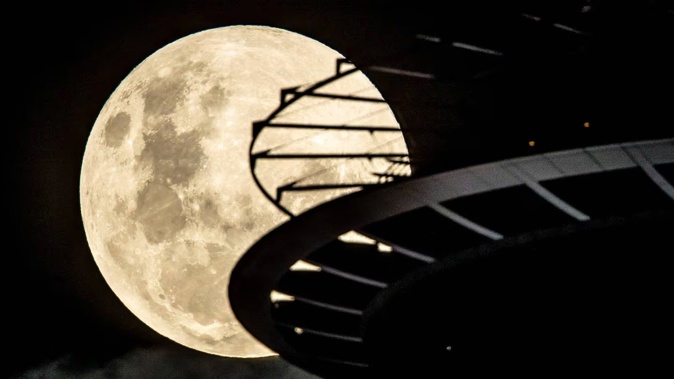
Comets, conjunctions, meteors and supermoons: there’s plenty on the calendar to keep stargazers busy in 2024. Science reporter Jamie Morton looks at the year’s highlights in space and astronomy.
Launches and fly-bys
It’s been helping answer some of scientists’ biggest questions about Jupiter – and this Saturday, Nasa’s Juno space probe is set to make its closest fly-by past its moon Io.
The spacecraft, which has been orbiting Jupiter since 2016, last month became the first probe in more than 20 years to travel within 1500km of a moon that happens to be the solar system’s most volcanic body.
After finishing its extended mission in September next year, Juno’s nine-year tour of the gas giant will come to a blunt end when it’s deliberately crashed into Jupiter’s atmosphere.
/cloudfront-ap-southeast-2.images.arcpublishing.com/nzme/EQMJBT6OORFULJIVXFOED22GQM.jpg)
Nasa's Juno probe has been orbiting Jupiter since 2016. Photo / Nasa
It’s not the only interesting close encounter on the cards this year: the European Space Agency (ESA)’s BepiColombo probe will whizz by Mercury on September 5, before entering its orbit at the end of 2025.
Meanwhile, other fascinating space missions are just about to begin.
Nasa plans to launch its Europa Clipper probe sometime in October – it’ll reach the smallest of Jupiter’s Galilean moons in 2030 – and its Viper Moon Rover in November, with an aim to shed light on our own moon’s shadowed areas.
The ESA is also due to launch its probe Hera in October with a mission to visit and investigate the asteroid pair Didymos and Dimorphos – the latter of which was famously used in a 2022 experiment to test if asteroids could be deflected from Earth.
Comets and conjunctions
Speaking of objects hurtling through space, Kiwis might be able to sneak a peak of the comet C/2021 S3, or PanStarrs – if they’re lucky next month.
Thought to have come from the comet-packed Oort Cloud - the most distant region in our solar system - the kilometre-wide PanStarrs should appear brightest in our early morning sky roughly on February 26.
Stardome astronomer Rob Davison said a telescope, or perhaps binoculars, will be needed to spot it – if a close-to-full moon doesn’t spoil the vista.
“A week or so earlier may be slightly dimmer, but the moon can be avoided.”
/cloudfront-ap-southeast-2.images.arcpublishing.com/nzme/YZBXYKBYABEYZH3SVYTPOWL7YA.jpg)
Comet PanStarrs may be visible in our skies late next month. Photo / Astronomy Education Services/Gingin Observatory
Later on April 21, the comet 12P/Pons-Brooks is set to make its closest approach to the Sun – but, again, viewing it then might be a challenge, as it’s likely to sit too close to our horizon.
Come September 27, Comet C/2023 A3 (Tsuchinshan-Atlas) - first observed just a year ago - will make its own closest approach to the sun.
“It will likely pass by the Sun once before being flung back out again, never to return - or at least not for many thousands of years,” Davison said.
“As it is a new comet, we don’t know an awful lot about it yet. This includes how brightly it may appear in the skies. It has potential, but it’s not guaranteed.”
Scattered throughout the calendar are also a series of conjunctions – where any two astronomical objects appear close together in the sky.
In eastern skies, there’ll be conjunctions of Venus and Mars on February 23, Venus and Saturn on March 22, and Mars and Saturn on April 11.
But the best is likely to be Mars and Jupiter, which will be visible higher in the north-east sky – and for longer – for a few hours before sunrise on August 14.
Supermoons and meteor showers
If the night skies are clear on May 5, Kiwis should have a great view of the peak of the Eta Aquariids meteor shower – with the Moon likely to just be a slither at most.
“Meteor showers occur when Earth passes through an area of natural debris as it orbits the Sun,” Davison said.
“These tiny pieces of rock or ice hit Earth’s atmosphere and shine briefly as they burn up.”
Most often, these were tiny remnants of a comet: and it was dust from the famous Halley’s Comet that caused the Eta Aquariids each year, along with the Orionids shower.
Davison said the Eta Aquariids was likely to be the best shower over New Zealand this year, as the well-known Geminids in December was likely to coincide with a near-full Moon.
/cloudfront-ap-southeast-2.images.arcpublishing.com/nzme/FZPKLEVDSBBLZFV6MIH2YY2VVI.jpg)
The night view of the annual Geminids in December is this year likely to be spoiled by a near-full Moon.
As for moons, a pair of “supermoon” events were marked on the calendar for September 18 and October 17.
“Supermoon sizes do vary a little, but it’s generally taken that they appear around 14 per cent bigger and 30 per cent brighter compared to when the moon is at its furthest point, also sometimes known as a micromoon.”
On March 25, a penumbral lunar eclipse – where some of the Earth was blocking some of the Sun – was also due to take place.
“This means all of the Moon’s surface, from our perspective, is still receiving some sunlight, which makes the effect extremely subtle.”
The average viewer was unlikely to notice anything, he said.
/cloudfront-ap-southeast-2.images.arcpublishing.com/nzme/PYW3MPQ53DZCELDU7BB53EW4HA.jpg)
A supermoon seen over Auckland in 2022. Photo / Brett Phibbs
“It’s only when a lunar eclipse reaches its partial phase that viewers would start to see the Earth’s shadow moving across the face of the Moon.”
A more spectacular sight would be a total solar eclipse on April 8: but it’d be crossing the continent US, rather than New Zealand, which will get treated to its own one in mid-2028.
Meanwhile, our key astronomical event on the calendar, Matariki, begins when the star will be visible in the early morning eastern sky from June 29.
The matariki period lasts until July 6 with the moon phase mutuwhenua, or the day before the new moon, whiro.
Jamie Morton is a specialist in science and environmental reporting. He joined the Herald in 2011 and writes about everything from conservation and climate change to natural hazards and new technology.
Take your Radio, Podcasts and Music with you









